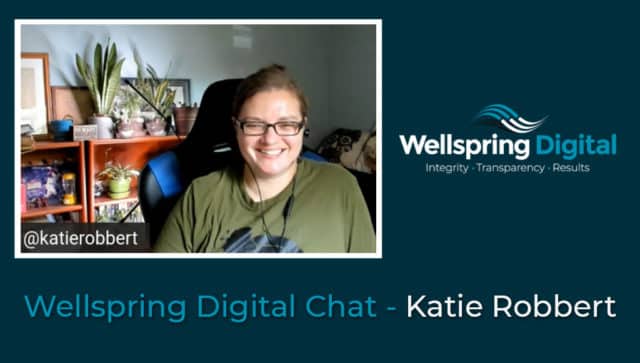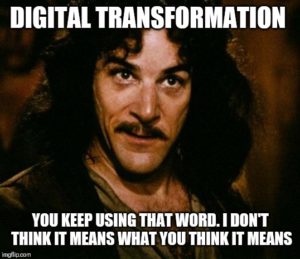Katie Robbert is instantly awesome in my mind through her business partnership with Chris Penn. If Chris believes in Katie enough to start a business with her, then we’re all more than lucky to have her on here.
In fact, something tells me that out of the two, Katie is the smarter one. Shh, don’t tell Chris.
Katie is one of those data wranglers who manages to make data and analytics accessible, meaningful, and dare I say… fun. There is a ton of great, actionable advice in this chat. I know you will enjoy it just as much as I enjoyed interviewing her.
We discussed…
- What is digital transformation, really?
- Understanding the marketing problem before the fix
- Google Analytics Four and the impending Analytics Apocalypse
- The impact of privacy updates
- Intercepting audience demand.
OK, let’s do this!
Digital Transcription (Edited for Readability)
Introductions
Jon-Mikel Bailey: Alright everybody, how you doing? You’re doing good. I’m glad. Welcome to the Wellspring Digital Chat. My name is Jon-Mikel Bailey, and this is where, through a major charm offensive, we’ve been able to sort of cajole, or convince, or otherwise con marketing experts to come and join us and share all of their useful knowledge. In an effort to improve marketing as a whole. We’re on a mission, we’re on a mission.
So I know of Katie Robbert, through her business partnership with Chris Penn, who I have a man crush on and is one of the most amazing humans I’ve ever met. But anyway, so if Chris believes enough in Katie to start a business with her, then I am more than lucky to have her on here. In fact, something tells me that out of the two, Katie’s the smarter one. Don’t tell Chris. I said that, because, okay, anyway. So, Katie, welcome. Please take a moment to introduce yourself to these fine, folks.
Katie Robbert: Well, thank you for that warm introduction. I’m very, very happy to be here. I’m Katie Robbert. As Jon mentioned, I am the co-founder and CEO of Trust Insights, I do work very closely with Chris, he does give me a headache on a regular basis. I don’t mean to ruin your man crush, he is a wonderful person.
You know, my primary role in the company is to keep the trains running, to herd the cats. Spoiler, I am not the data scientist on the team, that is Chris’s primary function. My role is to orbit around all of the data science and make it approachable, and understandable, to productize it, and to make to explain it in such a way that people are like, “Oh, okay, I do need this. This makes sense. For me.”
Jon-Mikel Bailey: You are definitely one of those people that manages to make data and analytics, accessible, meaningful, and even fun, which is a feat in and of itself. But I promise not to get into biological assays. If you watch their podcast, you’ll get this reference. If you don’t watch their podcasts, I highly recommend them. So anyway,
Katie Robbert: So which I believe I said to Chris, my first question would be how the heck do I spell biological assays, and I still don’t know what it is.
Jon-Mikel Bailey: I had to look it up. And I saw the explanation, and I still don’t know what it is. So only Chris. So you’re ready. Ready?
Katie Robbert: Ready.
Jon-Mikel Bailey: Awesome.
Digital Transformation
Jon-Mikel Bailey: So your newsletter is one of my absolute favorites. You and Chris take newsletters to the next level. And I’m not, this is not hyperbole, join their newsletter, I highly recommend both of them. They are absolutely next-level newsletters. In a reason version, you offer one of the best breakdowns of the buzzword, digital transformation, that I have ever seen. So my question is, what advice would you give a marketing professional whose boss just told them that their company needs digital transformation?
Katie Robbert: You know, it’s so funny. It’s one of those words that I love to hate. Because it really doesn’t, to me personally, it really doesn’t mean anything. At its core, digital transformation should be the introduction of digital technology into your team. However, it also becomes this bandaid of “Ooh, let’s just do a digital transformation and all of our problems will be solved.” And one of the things that I focus a lot on here at Trust Insights is change management.
Change management is comprised of people and processes primarily, I love alliteration. And a digital transformation quite often skips over the people and the process and focuses too much on the platforms and the technology. So let’s just build an app and suddenly we’ll attract the customers that we want. Or let’s add in a social listening tool. And suddenly we’ll know what everybody really wants from us.
That’s fine, but that’s sort of your end goal. That’s not actually what you need to do to get to solving the problem. So the first thing you really need to do is figure out what really is the problem we’re trying to solve. What is the purpose of feeling like we need a digital transformation, feeling like we suddenly need to add a whole bunch of tools on top of our tech stack?
And I think, in my experience, and from what I’ve seen from my clients that the number one issue is that they don’t know what problem they’re trying to solve, right? They just want that quick solution. But that quick solution isn’t solving a problem. So let’s say they suddenly decide to stand up a social listening platform. Okay, great. Do you have the people to operate it to analyze the data to set it up correctly? To maintain it?
Do you have a process of how often you’re going to be looking at the data and when you’re going to be updating the queries and those kinds of things? And those are the steps that people skip over in most projects, to be quite honest. Call it a digital transformation, call it an upheaval, call it growth, hack, whatever? People and companies forget about the people and the process and focus too much on the technology feeling like it’s a magic solution.
Jon-Mikel Bailey: You know, it’s funny, I think, you know, and just listening to you right now, it seems like companies are motivated by maybe they have a problem, and they want to solve it with technology. But if they don’t go about it correctly, they’re actually creating 10 more problems by bringing that type of technology in. And they’re unprepared for it, or they don’t necessarily know what their outcomes are, from that technology.
CDP – Customer Data Platforms
Katie Robbert: So, that’s exactly it. A really great example of that is a CDP. Now, I’m not knocking CDP’s, which is a customer data platform, the goal of a CDP is to have more of a single view of the customer. So what any one person is doing, how they’re interacting with your brand on the internet, and how they eventually become a customer. So that you can do a little bit more personas and profiling and understand who your ideal customer is. I think that’s a great solution.
However, in digging into a lot of the infrastructure of CDP’s, there’s a lot that goes into it, especially when you start to get into things like HIPAA, and PHI, protected health information, PII, personally identifiable information, and the rules around what you can and cannot collect. And in talking with a lot of these CDP companies, their stance, at least a couple of years ago was, “well, that’s up to the company, that’s up to the marketer to govern those things.”
Versus the CDP taking responsibility to say, “Okay, we’re gonna stop you at this gate, this data can’t be collected.” And so to your point, putting a piece of technology on top of a problem can introduce a heck of a lot more, sometimes legal issues, versus creating more solutions, if you’re not planning for it correctly, which is the core of the broken record that I repeat over and over again.
Understanding the Marketing Problem before Trying to Fix It
Jon-Mikel Bailey: So now that we’ve managed to scare the crap out of everybody, let’s jump into some SEO. In a recent episode of your podcast, So What, that’s the name of the podcast? You Chris, and I believe it was John Wall, do a deep dive into your own SEO, which I thought was a bold move. in it. There was one thing that you said that got my attention, and I’m gonna quote it, there’s more research to be done before you start trying to fix the problem. So when confronting poor SEO or website performance, and this is kind of in line with what we were talking about, what problems? Do you think that people often start looking for solutions before they understand the problem? And how would you suggest marketers start the SEO fix process?
Katie Robbert: They 100%, myself included, look for solutions before fully understanding the problem. So John and I were actually just talking about that this morning. We introduced a new plugin to our website, which is meant to auto-internal link a lot of different posts. And in looking at it, the idea of it is really interesting, but our execution of it was not really that great, it wasn’t well thought out.
And so we actually have to backtrack the work that we’ve already done and fix what we inadvertently broke because we didn’t have a fully baked plan. Because we ourselves were trying to put a solution on top of an unknown problem. And our problem is that we’re a small company, and we’re doing our best to hit all the different marks with on-site, off-site, all of the different components of SEO.
But sometimes we just don’t hit those marks because we have other things that we need to focus on. So by introducing a new plugin, we may not be solving our own SEO problem, we may just be introducing new issues on top of an existing issue. So that’s when I say there’s more research to be done.
I always, and not everyone has the luxury of this kind of time, but I always think about problems in terms of if I were a medical professional. Would I be saying, “Okay, so it looks like you have a bleeding ulcer, so let’s experiment with these 10 things to see if we can solve the problem,” versus really trying to diagnose what the heck is happening, even if it takes a little bit longer. You kind of want to get the right solution.
Jon-Mikel Bailey: Man, it’s funny, because we have a former client, and then part of that former client, they have a nonprofit, which is Save a Leg Save a Life Foundation. And that’s just right. And we just had that same exact conversation, which was, you know, before you cut off someone’s leg, maybe you should do a couple of things ahead of that. An extreme example, but yeah.
Katie Robbert: I think that sort of brings it back down to a realistic level. What we do at Trust Insights is not a matter of life or death, if our content around Google Analytics Four doesn’t get shown by a search engine, I’m pretty sure nobody’s life is going to be in perile because of it.
However, what happens is, because we know that we don’t then necessarily feel like we have to take all the correct steps in order to make it as pristine and correct as possible because it’s not a matter of life or death. And so there needs to be a little bit of that thinking of, “well, what if it was? What steps would we need to take if this was actually a piece of content that could be life-changing?”
And so it’s a little dramatic to put it that way. But there needs to be a little bit of that sense of urgency around doing things correctly versus “Well, we just fix people’s Google Analytics data. Who cares about that? You know, nobody’s gonna die because of it.” Theoretically, let’s hope so.
Google Analytics Four and the Impending Analytics Apocalypse
Jon-Mikel Bailey: So, sticking with Google Analytics Four and the impending apocalypse, many marketers are freaking out about the switch. Some aren’t even aware that it’s a problem. So I’m here to tell you it’s a problem. Can you offer calming words of wisdom on how they can prep themselves for this inevitability?
Katie Robbert: Yeah, absolutely. It’ll probably be like 50%, calm, 50% panic, just to, you know, be totally fair.
Jon-Mikel Bailey: So, maybe explain to people that don’t know what the problem is or the problem that’s coming?
Katie Robbert: Yeah, absolutely. So earlier this year, I believe it was March, Google made an announcement that they were going to make Google Analytics Four, which is the newer instance of Google Analytics (the traditional one that everyone’s been using for 10 to 15 years is Google Analytics Universal, also known as Google Analytics Three). So what Google said was, “what we feel like, we’re just going to screw you all over.
So on July 1, 2023, which don’t worry, it’s over a year from now, we’re just going to shut down access to data collection in Universal Analytics. But don’t worry, it’s over a year from now.” So that was the paraphrasing of what they said, that’s my interpretation of what they were saying…
Jon-Mikel Bailey: I’m sure that’s exactly how they put it.
Katie Robbert: I mean, I can go back and find the exact quotes where, hey, we’re gonna screw you over marketer, good luck. And so this, understandably, created panic amongst marketers who are using and relying on Google Analytics to make decisions. The problem with what Google is doing is that they’re basically saying, “There’s a cut-off point of when you can access your data in Universal Analytics, which is going to be six months from the time in which we say Google Analytics Four is the new standard.”
And Google Analytics Four being the new standard is July 1, 2023. And so the good news at the time was okay, you have over a year to get this set up. The other good news is that Google Analytics Four is still free. You don’t have to buy 360 which is way overpriced for not a whole lot of stuff. So everybody’s like, “okay, great. I got the announcement. I don’t have to worry about this today.”
The panicky side of things is that if you didn’t get at least some instance of Google Analytics Four set up by July 1 of this past year, which as of this recording was just what 26 days ago, you will not be able to do a year over year comparisons with your data come July 1, 2023. The reason for that is because Google, in their effort to screw us all over, has basically changed the definition and scope of the metrics between Universal Analytics and Google Analytics Four.
So goal conversions, for example, are the way in which people interact with your website and actually take an action that you want them to take, such as, I don’t know, purchasing something, or filling out a form, or contacting you, to the things that are most important to companies, right? Those definitions are not one-to-one between the two systems.
So you can’t say on May 29, 2022, and May 29, 2023, “Here’s what happened, we went up or down.” If you didn’t have Google Analytics Four in place on May 29, 2022, with your new goals configured, which by the way, you no longer configure in Google Analytics, you now have to configure them in Tag Manager. So if you’ve been running Google Analytics, without Tag Manager, that is no longer an option. So you now have to also learn Tag Manager. Unfortunately, Jon, I gave people more panic than calm and I apologize for that.
Jon-Mikel Bailey: Did you hear that? Did you hear that? That was a collective gasp of every marketer out there.
Katie Robbert: Well, here’s the calm part, I can help you. Let me take on your panic. Let me be the one to worry about it, I can help you. I will let you worry about other things. You can be calm about Google Analytics.
Jon-Mikel Bailey: And you all have a course out there that I would highly recommend that you can find on I’ll put a link in the description below. But what is your website, trustinsights.com?
Katie Robbert: It’s trustinsights.ai.
Jon-Mikel Bailey: That’s right.
Katie Robbert: And so yes, thank you, we do have a course for Google Analytics. And one of the things that we really tried to do sort of going back to our conversation on things like digital transformation and SEO is, we really tried to make it a full 360 experience in terms of, it’s not just about you learning the technology, but it’s about…
- learning how to introduce it to your team
- update your processes
- if you need to hire this is a whole new skill set
- here are the things that you need to look for
And so really thinking about our five P’s of change management, which is purpose, what is the reason for Introducing Google Analytics Four? For some companies, it’s not the right solution, because it’s very technical. It’s very complex, now, the way that Google has rethought it. It might not be the right solution. So maybe an open-source solution, like Matomo, is a better option.
So really thinking through the purpose of migrating from Universal Analytics to Google Analytics Four, who are the people who need to be involved? What are the processes in which you currently use it, gather data, and then so on, and so forth? So we really tried to think through the full experience of introducing new technology, which is what this is to your team.
Jon-Mikel Bailey: That’s great, highly recommend it.
The Impact of Privacy Updates and Our Cookie-Less Future
Jon-Mikel Bailey: So speaking of things that are going away, and I’ve asked others this next question, I’m curious to hear your take. We seem to be heading towards the end of the cookie era. So how do you see privacy updates on major platforms affecting things like PPC, SEO, and marketing automation? I mean, how will this affect marketers in the future?
Katie Robbert: I think it’s going to force us to be better marketers, quite honestly.
Jon-Mikel Bailey: Amen. Sister.
Katie Robbert: Well, you know, there’s, by, you know, using cookies, it quite honestly, it allows us to be lazy, and not really personalize and customize and really think through is this the thing that someone wants at this moment in time. I don’t remember the exact article on LinkedIn. But there was some article a few months ago saying that there’s a very quick snapshot in time where people are actually interested in buying something from you.
And it is such a small window, you need to know how to reach that person at that right time. The rest of the time. Your job is brand awareness. That’s all your job is. And so I actually feel like the “cookie-less future, it’s not a bad thing. Because what it’s going to do is it’s going to weed out the brands who have sort of taken that lazy I can just cookie everything approach versus let me actually think about the customer experience.
Let me actually think, “Am I reaching the right audience?” Let me ask. For people to opt into getting information from me versus I think I was looking at a pair of sneakers the other day, and now I’m seeing ads for them everywhere. Well, I don’t even want the damn shoes. Why do I have to see ads for them literally everywhere, including, when I’m checking the weather? I just want to know, if it’s humid outside. I don’t need to know if I still don’t want this pair of shoes.
And so I feel like a cookie-less future is definitely not a bad thing for marketers who are interested in really understanding what their audience wants. And when I think it’s a fantastic thing, those marketers will be fine. The companies who haven’t really figured out how to look at an attribution analysis, a customer journey, any of that stuff, you know, they’re gonna struggle a bit.
And I think, that’s fine, good, let them struggle, let them figure it out. We as consumers don’t want things shoved in our face every second of every day, for weeks, we kind of want to break from it.
Jon-Mikel Bailey: You know, it’s funny, it’s like, all this technology, and it’s so improperly used so very often. I mean, my favorite is when you buy something, and then you see the ads for the thing that you just purchased. And I’m like, part of me feels bad for the marketer that’s wasting their money. But that part of me goes away real quick. And then I feel like you better figure this out. This is silliness.
Katie Robbert: I wholeheartedly agree. And it’s such a waste of resources and budget to continue to put ads against something that someone has already purchased. That is a really great example of how companies are just getting it wrong, and they’re just being lazy about it.
Jon-Mikel Bailey: Man, we are in the wild west still. It’s like, you know, if we could all peer five years into the future, I think we would probably have an aneurysm or something because we’d be just so overwhelmed with the differences in how things are done.
Katie Robbert: I agree. I think it’s, you know, we’re constantly trying to hack things and shortcut things. Just ask people what the heck they want. Give them that.
Jon-Mikel Bailey: It doesn’t work, folks.
Katie Robbert: Yeah, you’ll never get away from that. You will never be able to shortcut that.
Intercepting Audience Demand
Jon-Mikel Bailey: So I have one last question for you. I want to ask you about something you said in a recent post on micro forecasting, which was “instead of trying to stimulate demand for a product or service that our audience may or may not want, it’s easier to intercept the audience’s demand.” So to me, this is kind of what we’re talking about. I mean, this is the essence of the power of modern marketing. And, you know, can you talk a little bit about what you meant by this? And how this type of thinking can impact how marketers, or why marketers should think more about strategy?
Katie Robbert: It’s funny, because as you were quoting that, I was like, “did I really say that? That’s smart.” I don’t remember saying that. That happens to me a lot of like, when was my brain coherent enough to string together a full sentence that actually sounds like I know what I’m talking about?
Jon-Mikel Bailey: All of my best thoughts come during an out-of-body experience.
Katie Robbert: Mine is usually when I’m riding my bike. And I don’t have anything around me to write something down with. So I just have to like…
Jon-Mikel Bailey: Wind in your hair.
Do People Actually Want What You’re Selling?
Katie Robbert: So basically, what it comes down to is, it’s back to the core of what we’ve been talking about is creating solutions when you don’t even really know what the problem is. And so I think about a company I used to work for, where we had this, I started with a clinical trial. So we did the clinical trial to determine the efficacy of the instrument. And then phase three of the clinical trial was to turn the instrument into a commercial product.
So we had already demonstrated that the instrument was effective, but what we hadn’t done a great job of was determining, do people actually need this thing. And so it was such a mismatch between academia and commercialism, which, you know, shocker, happens a lot. And so, we struggled to sell this, to monetize this product, because the audience was like, “We are substance abuse facilities, we have no money. We have such high turnover of our clinicians and now you’re asking us to pay for this thing that we can already do with a piece of paper. Stop trying to shove this on me.”
And so we struggled with that and if something you know, it was a tough lesson to learn as a product manager that just because you create something that’s effective doesn’t mean people want to use it, doesn’t mean that it’s fixing a problem. The problem that these counselors were having was that they had too many people to see, and not enough staff to see them, not enough resources.
And our technology solution was just one more thing for them to consider that they didn’t have time to learn to train. Now, if they had been able to incorporate it, it would have saved them time. But the upfront overhead of incorporating it into their process, they just couldn’t, you know, they couldn’t take that on.
And so when I think about this idea of creating demand for people who may or may not want the thing, what that says to me is that companies, Trust Insights included, we haven’t fully done our audience research to say, “does this actually solve a problem? And is the problem big enough that you’re willing to change your everyday habits in order to take our solution and give it a test run?”
A really great company that does that kind of user research that I’ve always idolized is IDEO. So I, D, E, O. They are really the gold standard of user research and user experience and really trying to understand what is the problem that someone’s actually having before we start throwing solutions at it.
Jon-Mikel Bailey: There’s just so much tasty goodness in there, I just don’t even know. It brings us back to our whole earlier discussion before we recorded about cookies. But yeah, her husband doesn’t like cookies. So um, it’s a problem. And it’s, it’s very concerning, and I’ve alerted the authorities.
But anyway, you know, when you were talking, I was instantly thinking about when you go to a doctor now, they spend more time staring at their laptop and typing notes on their laptop than they do actually with the patient. And that is anti customer experience. So yeah, that’s great stuff. Well, that’s our time. And there is so much great stuff in here. I really appreciate it. And yeah, just keep on doing what you’re doing. Fight the good fight.
Katie Robbert: I will do my best. I welcome people to send me cookies, not internet cookies, but actual cookies. Chocolate Chip is the best followed by oatmeal chocolate chip, and peanut butter. You know, nothing with nuts or raisins. That’s just weird.
Jon-Mikel Bailey: I like a good, chewy sugar cookie.
Katie Robbert: I agree.
Jon-Mikel Bailey: All right. I’m hungry now. Thanks. Bye, everybody.





